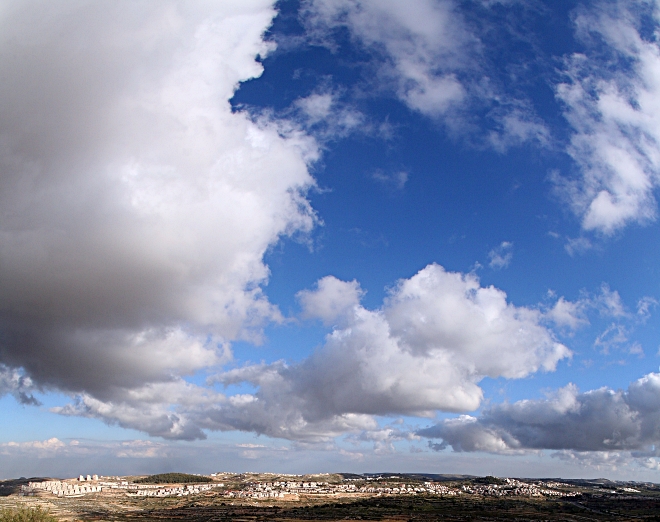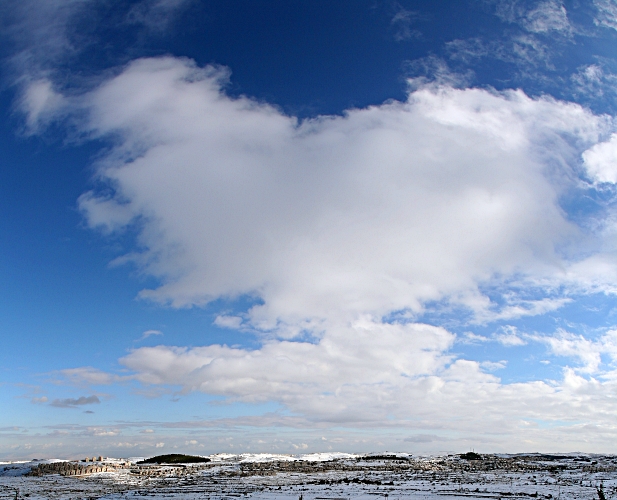Menachem's Writings
My Home Town, EFRAT
A personal journey
I live in Israel, in a town called Efrat. Efrat is the Biblical alternate name for Beit Lechem, Bethlehem (see the B'reshith, Genesis and the Book of Ruth). Today it is situated a few kilometres south of modern-day Bet Lechem. When we moved into this area, the population of Bethlehem [as well neighbouring Beit Jala and Beit Sahur] was at least 70% Christian. Today it is some 80% Muslim.
Because our city of Efrat is not located within the boundaries of Bethlechem, the Israel National Names Committee decided that we should be called Efrata. However no-one here uses that name. One of the members of that committee lives here, and he too refuses to call out town Efrata. Their implication is supposed be that we are not exactly at the location of the Biblical Efrat, only in its region.

|
|
Summer afternoon panoramic view of the city of Efrat photographed from Neve Daniel to the north-west Please look at my diverse photographs of Efrat |
The first people to move into Efrat arrived around Pesach 1983. So we are now celebrating 25 years of populated existence :-) Efrat, like Rome, is built on 7 hills: Rimon, Te'ena, Gefen, Dekel, Zayit, Tamar and Dagan in order of existence. In addition, the parallel ridge of Eitam is also slated to be part of Efrat, though the Israeli Government decided to build a partition wall (to partition between Arabs and Jews) between the seven hills and Eitam, scarring the Land irreparably.
I first came to (the site of the future) Efrat in December 1976 specifically to "check it out" with a view of eventually coming to live here. The [first] Rabin Government had just then recently approved the building of Efrat, and we were armed with maps from Moshe Moskovitch, a former resident of the original, destroyed Gush Etzion settlement bloc of 1948. He had lived in the moshav shitufi (communal settlement, but not quite as communal as a kibbutz) of Massuot Yitzchak, named interesting enough after the first Chief Rabbi of Israel, Rabbi Isaac Herzog, who was also first Chief Rabbi of the Irish Free State and the second Chief Rabbi of the British Mandate of Palestine following Rav Kook (who actually spelt his name Kuk). I say interesting because then, as now, it is very rare to name anything around here after a living person. In fact in Jerusalem you have to have been dead for a least three years before you can get a street or roundabout named after you (just in case something unsavoury later comes out of the woodwork about you).
Moskovitch, more than anyone else, is responsible for the redevelopment of Gush Etzion, including the building of Efrat. He became the first Mayor of Efrat, though he never lived here. He still lives in the rebuilt moshav of Massuot Yitzchak, located near Ashkelon. As they say, "if you want to be a mayor, build your own town". [Attributed to Meir Dizengoff, first mayor of Tel Aviv.]
Moshko's maps led us to what is today the hill of Zayit. There were then three Arab houses (we assumed Bedouin from the style) on the hill. Otherwise the whole area, in every direction, was deserted. When Efrat was finally built, the first suburb was Rimon, the southernmost of the seven hills. This, I later found out, was because it was the closest hill to the already established Alon Shvut and the rest of Gush Etzion. This proximity reduced the cost of laying sewage pipes for the new town -- you see most people (planners) never really believed that Efrat would grow too much, even though officially they were building a town of 5,000 housing units over a north-south length of some five kilometres -- a sausage-shaped town. Rabbi Shlomo Riskin, the rabbi of Efrat tells the story somewhat differently, and it is good there are dreamers. In practice terms Efrat did not start from the south in order for it to be close to Hevron, the City of the Patriarchs.
Unlike almost every other yishuv, town, (settlement in the language of the antisemites of the world) in Israel, Efrat did not go through a stage of living in what in Hebrew is called caravans, in reality, prefabs that can be moved whole on the back of a big truck.
Also Efrat was open to all Jews without the need to pass ridiculous psycho-something examinations, handwriting checks and the scrutiny of an Acceptance Committee. This meant that, at least in theory, Efrat could develop quickly, existent demand only tempered by the availability of housing rather than bureaucracy. (Of course all along, demand outstripped supply, helped along by our fearless leaders who were greedily keen to maintain the value of their own housing prices.)
Most people still do not realise that the Acceptance Committees are the government's way of ensuring that the yishuvim, settlements, do not grow too much. Our governments like to keep non-like-minded beings like us under check. Of course the settlers will tell you that the committees are to ensure an homogeneous population -- as if I want to live next door to myself or someone else just like me -- and keep out undesirables (like me?). It still amazes how easy it is to fool Israelis, especially the [so-called] religious Zionist ones. This was just one of the government's tool to slow development of yishuvim. [Perhaps more on this another time.]
I eventually moved to Efrat in August 1985, after about 160 families were already here, with my wife, Jill Kuchar, publisher for many years of the Gushphon, the Gush Etzion local-area phone book, and three children, Yisrael 5, Elisha 3 and Michal 1 (month that is). We still live in Rimon in the same house we moved into back then. (I shall not discuss the state of the houses due to the superior building techniques used back then. The Arabs built very primitively, because they knew no better. However our architects, engineers and contractors were all Jewish -- and should all be ashamed of themselves. Please do not assume their low standard work came cheaply -- it did not!)
During the time we have lived here we have, by the Grace of the Almighty, had three more children (for the moment): Honi (no, we are not related to Hagar the Horrible), Meital who sometimes spells her name Maytal, and Aviel named after King Shaul's grandfather, also known as Ner.
Menachem Kuchar, 27th June, 2008
12th Tamuz, 5768

|
|
Winter Panorama of the city of Efrat, covered in a blanket of snow, photographed from Neve Daniel to the north-west |
Previous posts: